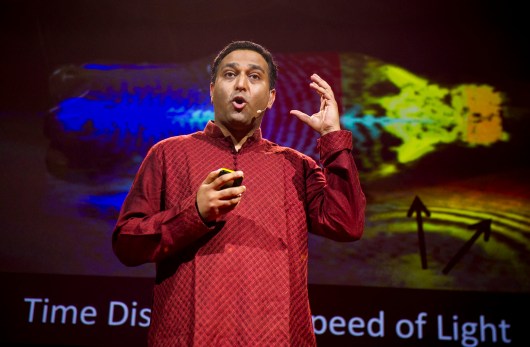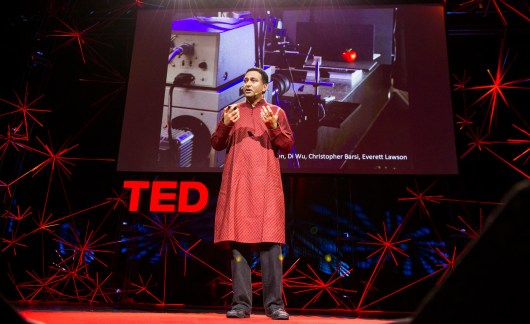MIT professor Ramesh Raskar starts his talk by showing the classic Doc Edgerton photograph of an apple being shot by a bullet. It demonstrated an exposure of a millionth of a second. Wonderful, right? he asks us, to wide agreement. Only now, 50 years later, technology advances mean we can photograph a million times faster than this. “Now we can see the world at a trillion frames per second,” he says. “I present to you femto-photography, a new imaging technique so fast that it can create slow-motion videos of light in motion.”
What does this mean? Well, it means that now Raskar and co can create cameras that look around corners. “We can challenge what we mean by camera,” he says.
He shows video of a “bullet” of light passing through a Coke bottle. The film is silent and slow, and someone whoops excitedly as soon as it’s over. That guy’s grasped what Raskar now explains to the rest of us: “This would take place in less than a nanosecond. It’s slowed down by factor of 10 billion,” he explains.
Next, Raskar shows video of a pulse of light hitting a tomato. “It’s like throwing a stone into a pond of water,” he says of the ripples of light, describing this as how nature paints a photo. And why does the tomato continue to glow even after the light has gone? Because it is ripe, he tells us. The light bounces around inside the tomato. That means that in the future, when we have femtocameras in our cell phones, we’ll be able to check if fruit is ripe in the supermarket.
But that’s not all the femto-photography can do. It’s a superhero in its own right. By manipulating light, it’s possible to look around corners. This is really possible, he tells us. It’s not magic. They’ve done it. “We can look at the world at the speed of light.”
[youtube http://www.youtube.com/watch?v=JWDocXPy-iQ&w=560&h=315%5D
There’s some way to go before this will leave the lab, he acknowledges. But the implications are exciting and vast. Imagine a car that could avoid an upcoming collision around the next bend. Or a rescue operation that could detect buried people. Or new types of cardioscopes or endoscopes for healthcare. Scientists, meanwhile, can think about femto-photography as a way to solve the next generation of health imaging.
Just as Edgerton’s scientific experiments became art, perhaps too could femto-photography become a new artform. Already Raskar has noticed some strange effects within the still shots of the ripples of light. “Einstein would have loved to have seen this picture,” he says of one of the frames.
Whatever its eventual application, Raskar finishes with a wonderful announcement. All of this is now open source. “Our hope is the DIY-ers, the creatives and the research community will show us we should stop obsessing about megapixels in cameras and start focusing on the next generation in imaging. It’s about time,” he concludes. The audience laughs, loves and rises to its collective feet.
(And in a Q&A, Raskar shares another, unrelated, but equally fantastic invention: NETRA, a snap-on lens for an iPhone that can quickly diagnose nearsightedness and even cataracts.)
Photos: James Duncan Davidson


Comments (8)
Pingback: Femto Photography: One Trillion Frames Per Second | ASTOUNDE.com
Pingback: Femto-photography : The high speed imaging technology! | PZYCODERZ
Pingback: 1,000,000,000,000 Frames/Second Photography – Ramesh Raskar … | Bear Tales
Pingback: Fora de Ordem |